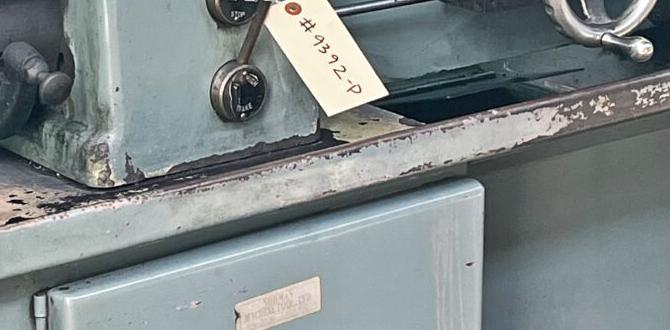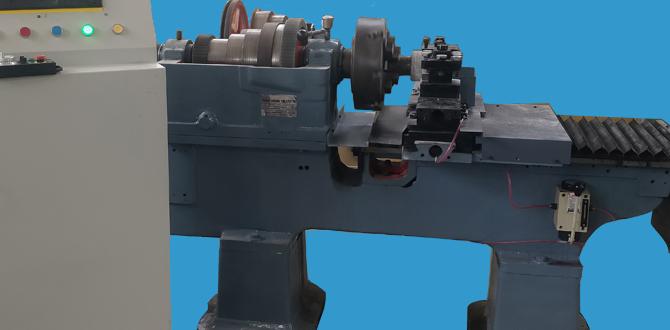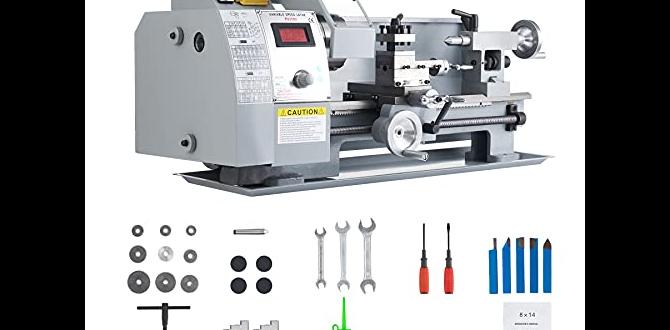Carbide end mills are excellent for cutting bronze due to their hardness and heat resistance, providing efficient material removal and a fine finish. This guide will show you how to select and use them effectively, even for beginners.
Working with bronze can sometimes feel a bit sticky or challenging, especially when you’re just starting out with machining. You want to get a clean cut without gumming up your tools or struggling to remove material. It’s a common hurdle for many hobbyists and beginners exploring metalworking. But what if I told you there’s a cutting tool that makes bronze machining a breeze? That tool is the carbide end mill. In this article, we’ll explore why carbide end mills are the secret weapon for tackling bronze and how you can use them with confidence in your own workshop. Get ready to make that bronze sing!
What is a Carbide End Mill and Why It’s Great for Bronze
An end mill is a type of milling cutter, essentially a rotating cutting tool that can cut in three directions: down into a workpiece and sideways. Think of it like a drill bit that can also move horizontally. The “carbide” part refers to the material it’s made from – tungsten carbide. This material is incredibly hard, much harder than the high-speed steel (HSS) typically used for many cutting tools.
So, why is this super-hard material a “genius” choice for bronze? Bronze, while easier to machine than steel, can still be a bit gummy. It has a lower melting point and can tend to “stick” to cutting tools, causing them to dull quickly or even break. Carbide end mills excel here for a few key reasons:
- Extreme Hardness: Carbide is significantly harder than bronze. This means the end mill edge stays sharper for longer, allowing you to cut through the material efficiently without excessive wear.
- Heat Resistance: Machining generates heat. Bronze can get hot and become softer or harder to cut. Carbide can withstand much higher temperatures than HSS before it begins to soften, which is crucial for consistent cutting performance.
- Rigidity: Carbide is also a denser and more rigid material. This means less deflection during cutting, leading to more precise cuts and a better surface finish on your bronze parts.
- Higher Cutting Speeds: Because they are harder and more heat-resistant, you can often run carbide end mills at higher speeds and feed rates than HSS tools. This translates to faster machining times – a big win for any workshop!
When you start looking for end mills specifically for bronze, you might see descriptions mentioning things like “1/8 inch diameter, 1/2 inch shank, extra long,” and combinations geared towards “high MRR” (Material Removal Rate). This just means the tool is designed for efficient, fast cutting. An 1/8 inch diameter is great for detail work or smaller parts, while a 1/2 inch shank offers rigidity. “Extra long” flutes can be helpful for reaching into deeper pockets or for specific machining operations on bronze. All these features, when combined with carbide, make for a superior cutting experience on bronze.
Choosing the Right Carbide End Mill for Bronze
Not all carbide end mills are created equal, and picking the right one for bronze is key to success. Here’s what to look for:
End Mill Geometry: The Profile Matters
The shape and flute count (the spiral grooves on the tool) of an end mill are important:
- Number of Flutes:
- 2-Flute: These are excellent for softer metals like aluminum and bronze. They offer good chip clearance, which is vital for preventing ‘chip packing’ – where the soft bronze clogs the flutes.
- 4-Flute: While generally better for harder materials or finishing operations in steels, 4-flute end mills can also work for bronze, especially if you’re prioritizing a better surface finish. However, they have less chip room, so managing chips is more critical. For general bronze cutting, especially when aiming for higher MRR, 2-flute is often preferred.
- Flute Type:
- Square End Mills: These have flat tips and are the most common type. They’re versatile for general milling, slotting, and profiling.
- Ball End Mills: These have a rounded tip and are used for creating complex 3D surfaces, fillets, or carving.
- Corner Radius End Mills: These have a small radius at the tip’s corners, which can add a bit of strength and prevent chipping compared to a sharp square corner, while still allowing for clean profiles.
- Coating: While not always necessary for basic bronze machining, some coatings can further enhance performance. Uncoated carbide is often perfectly fine for bronze. If you see coatings like TiN (Titanium Nitride) or AlTiN (Aluminum Titanium Nitride), they can offer increased hardness and reduced friction, though they add to the cost.
Material and Size Considerations
When searching for your bronze-cutting carbide end mill, pay attention to these specifics:
- Carbide Grade: Most general-purpose carbide end mills are made from a fine-grain tungsten carbide suitable for a wide range of materials. For very specific applications, you might see material grades, but for beginners, focusing on the geometry and flute count is usually enough.
- Diameter: This is the width of the cutting portion of the end mill. Common sizes include 1/8 inch, 1/4 inch, 3/8 inch, and 1/2 inch. The choice depends on the detail of your work and the size of your milling machine. A 1/8 inch end mill is great for intricate details in models or smaller fixtures, while a 1/2 inch is for removing larger amounts of material quickly.
- Shank Diameter: This is the part of the end mill that fits into your milling machine’s collet or tool holder. A 1/2 inch shank is very common and provides good rigidity. Shorter shanks offer maximum rigidity, while longer ones allow you to reach deeper into your workpiece or machine features that are far from the edge. If you see “extra long” or “extended reach,” it means the flute length or overall length is longer than standard, allowing for deeper access.
- Length of Cut (Flute Length): This is how far down the end mill the cutting flutes extend. If you need to cut deep slots or pockets, you’ll need an end mill with a longer flute length.
Recommendations for Bronze
For general bronze machining, especially when learning:
- Start with a 2-flute, uncoated, square-end carbide end mill.
- Consider a diameter that suits your project, like 1/4 inch or 3/8 inch.
- A standard flute length will often suffice, but if you know you’ll need to reach deep, look for “extended reach” options.
- A common and versatile tool might be something like a 1/4 inch diameter, 4 flute, carbide end mill with a standard length of cut and a 1/4 inch shank. However, for high MRR and good chip clearance in softer materials like bronze, a 2-flute is often superior. A 1/8 inch diameter, 2 flute, carbide end mill with a 1/4 inch shank is excellent for smaller details and a good starting point for intricate work.
A good starting point for learning to machine bronze might be:
2-Flute, Square End, Carbide End Mill, 1/4″ Diameter, 1/4″ Shank, 3/4″ Length of Cut.
Setting Up Your Milling Machine for Bronze
Once you have your carbide end mill, it’s time to get your milling machine ready. Proper setup is crucial for safety and for achieving good results.
Workpiece Clamping
Your bronze workpiece needs to be held securely. Any movement will result in inaccurate cuts or, worse, a dangerous situation.
- Vise: A sturdy milling vise is the most common way to hold your workpiece. Ensure the jaws are clean and the vise is properly aligned with the machine’s table.
- Clamps: For larger or irregularly shaped pieces, you might use clamp kits. These allow you to bolt the workpiece directly to the milling machine table or a fixture plate.
- Parallel Accessories: Use parallels under your workpiece in the vise to lift it closer to the vise jaws, ensuring a more stable grip and preventing the vise from marring the bottom of your part.
For small parts or detailed work where a vise might be too large, you might consider using specialized fixtures or even holding the part in a 5C collet chuck if your mill supports it.
Tool Holder and Collet
The end mill needs to be held securely in the milling machine’s spindle. This is done using a collet and collet chuck or a dedicated end mill holder.
- Collets: These are tapered sleeves that grip the shank of the end mill. You insert the collet into a collet chuck (like a YG-1 or ER collet system), and tightening the chuck draws the collet in, gripping the end mill firmly. Ensure the collet size precisely matches the shank diameter of your end mill. For example, use a 1/4 inch collet for a 1/4 inch shank end mill.
- End Mill Holders: These are specialized holders designed to grip the shank of an end mill. They often offer higher rigidity than collets for heavy cuts.
It’s important to insert the end mill shank deep enough into the collet or holder to provide maximum support. Avoid using end mills that are “bottomed out” in the holder; there should be a small gap. This is where an “extra long” end mill might require a holder with a deeper reach.
Setting Speeds and Feeds
This is one of the most critical parts of machining. Getting the speed and feed right will determine if your end mill cuts cleanly or burns up. Speeds and feeds are influenced by the tool material (carbide), the workpiece material (bronze), the diameter of the end mill, and the number of flutes.
Here’s a general guideline to get you started. Online calculators are invaluable here! A great resource is the Iscar Cutting Speed Calculator. For bronze, you’ll typically be using moderate spindle speeds (RPM) and a decent feed rate.
Rough Guidelines for Carbide End Mills in Bronze:
| End Mill Diameter | Surface Speed (SFM) | Spindle Speed (RPM) | Feed Per Tooth (IPT) | Feed Rate (IPM) |
|---|---|---|---|---|
| 1/8″ (0.125″) | 200 – 300 | ~600 – 1000 | 0.0005″ – 0.001″ | ~6 – 20 |
| 1/4″ (0.250″) | 200 – 300 | ~300 – 475 | 0.0008″ – 0.0015″ | ~20 – 70 |
| 3/8″ (0.375″) | 200 – 300 | ~200 – 315 | 0.001″ – 0.002″ | ~40 – 125 |
| 1/2″ (0.500″) | 200 – 300 | ~150 – 235 | 0.0015″ – 0.0025″ | ~70 – 190 |
Spindle Speed (RPM) = (Surface Speed (SFM) 3.82) / Diameter (inches)
Feed Rate (IPM) = Feed Per Tooth (IPT) Number of Flutes * Spindle Speed (RPM)
Important Notes:
- These are starting points. Always listen to your machine and tool. If you hear screaming or chattering, adjust your speeds/feeds.
- Bronze alloys can vary. Softer bronzes will perform better at higher speeds.
- For finishing passes, you’ll typically use a slower feed rate and potentially a slightly higher spindle speed to achieve a better surface finish.
- Always perform a “plunge test” or “air cut” if unsure to verify your G-code or manual movements.
For a beginner, starting on the lower end of these ranges for RPM and feed rate is a wise approach. You can gradually increase them if the cut is smooth and chips are forming nicely.
Another critical factor is the depth of cut (DOC) and width of cut (WOC). For high MRR with a standard end mill, you want to take as much material off as possible per pass without overloading the tool. However, with softer materials like bronze, it’s often better to take shallower depths and widths of cut to manage chip formation and heat, especially with smaller diameter end mills.
- Depth of Cut (DOC): For 1/4″ end mill, a DOC of 0.100″ to 0.250″ is a common starting point.
- Width of Cut (WOC): Aim for a WOC of about 20-50% of the end mill’s diameter when slotting. For profiling (taking a cut along the outside edge of your part), you can often take a WOC equal to the full diameter.
Always ensure your Depth of Cut is less than or equal to the flute length of your end mill!
Coolant and Lubrication
While some machinists might run carbide dry on bronze, using a cutting fluid or lubricant can significantly improve cutting performance, reduce heat, and extend tool life.
- Cutting Fluid: Flood coolant systems (if your mill has one) are ideal for removing heat and flushing away chips.
- Lubricant/Mist: For manual machines, a simple spray bottle with a mild cutting fluid, or a mist coolant system, can be very effective. Look for products specifically designed for machining aluminum and copper alloys.
- Hand Application: You can even use a brush to apply a little cutting oil or even WD-40 directly to the cutting zone.
The goal is to keep the tool and workpiece cool and prevent chips from welding onto the cutter. For bronze, a good quality semi-synthetic or synthetic cutting fluid at a 5-10% dilution is often a great choice.
Step-by-Step: Machining Bronze with a Carbide End Mill
Let’s walk through a typical milling operation. We’ll imagine we’re creating a simple square pocket in a block of bronze.
Step 1: Prepare Your Workpiece
Ensure your bronze block is clean and free from any surface imperfections. If it’s a rough casting, you might want to face off the top surface first to create a flat reference plane.
Step 2: Secure the Workpiece
Place the bronze block squarely in your milling vise. Use parallels under the workpiece to get it level with the top of the vise jaws. Tighten the vise firmly. Double-check that the workpiece is not going anywhere.
Step 3: Install the End Mill
Select the appropriate end mill (e.g., a 1/4 inch, 2-flute carbide square end mill). Clean the shank and the collet. Insert the end mill into the collet, slide the collet into the chuck, and tighten the chuck to secure the end mill. Ensure the end mill is inserted to a sufficient depth within the collet, not just barely held.
Step 4: Set Your Zero Point (Work Offset)
This is where you tell the machine where the “home” or zero position of your workpiece is. This is usually done at a specific corner or the center of your part. Use a digital readout (DRO) or a probe to accurately locate your desired X, Y, and Z zero positions. For Z zero, it’s often set at the top surface of your workpiece.
Step 5: Program or Manually Machine the Pocket
If you’re using a CNC mill, you’ll program the toolpath to create the square pocket. For manual milling, you’ll use the machine’s handwheels to move the cutting head.
CNC Example (Simplified G-code snippet):
G00 G17 G40 G49 G80 G90 G54;
T1 M06 ; Tool Change to T1 (End Mill)
G43 H1 Z.





